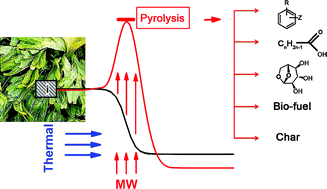| On the ethenolysis of natural rubber and squalene. Plenio and Wolf report the utilisation of natural rubber and squalene to obtain a set of terminal olefins. The main focus for producing olefins from renewable resources has been on plant oils. Despite the fact that the annual production (2007) of natural rubber was 9.7 × 106 tons, this polyolefin has not been widely used. However, due to the high degree of stereoregularity (in terms of double bond geometry and orientation) of natural rubber and squalene, Plenio was able to obtain controlled polymer degradation which resulted in the synthesis of sveral small oligoisoprenes. Future work is going to be directed scaling up this reaction and ultizing the products for the synthesis of flavours, odorants, etc. (Green Chem., 2011, DOI: 10.1039/c1gc15265c) |  |
 |
Microwave-mediated pyrolysis of macro-algae. Macro-algae is an abundant but generally underutilised resource – currently less that 1% is used. Its integration into a biofrinery is challenging as it contains increased levels of halogenated compounds, alkali earth and heavy metals which restrict its use in direct combustion. In this work, Clark and co-workers report the effective pyrolysis of macro-algae using a microwave. Pyrolysis is an established technique for deconstructing biomass using heat under an inert atmosphere to obtain high-value chemicals and platform molecules. In this study chemical rich bio-oils were obtained from macro-algae at temperatures lower than those used for conventional biomass and by using microwave irradiation they obtained a higher yield (21%) than that obtained with conventional heating (14%). (Green Chem., 2011, DOI: 10.1039/c1gc15560a) |
Utilizing natural resources – ethenolysis of natural rubber and pyrolysis of macro-algae
08 Jul 2011










